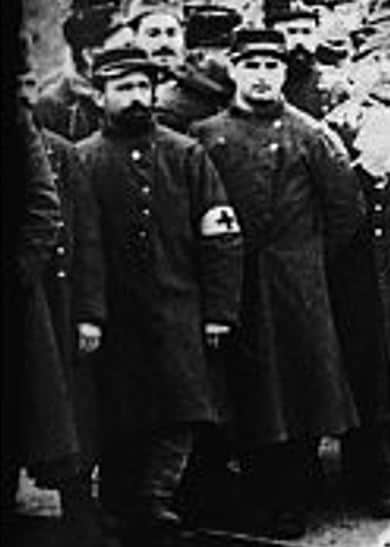Featured image from Library of Congress.
Image 1: French Prisoners Singing in 1914

Bain News Service, Publisher. Germany — French prisoners singing. , ca. 1915. [Between 1914 and] Photograph. https://www.loc.gov/item/2014699433/. See source.

The prisoners are holding books as they sing, likely French translations of a particular German song. Perhaps the German anthem? 
The red armband on this man suggests that this could be a field medic. If so, the darker coats of the surrounding officers could signify additional medics. Are these Germans or French? 
Presumably the German officers watching this event unfold.
Image 2: Wounded Russian Soldiers in 1915

Bain News Service, Publisher. Wounded Russian prisoners. , ca. 1915. [Between and Ca. 1918] Photograph. https://www.loc.gov/item/2014703155/. See source.

This seems to be a prisoner so wounded he has to be carried. Notice that we can’t see the injuries. This man might have lost his legs in combat which is shielded from the camera. 
We see an empty carriage lying listlessly. Russia was once very agricultural and very poor. A sample of Pre-Soviet Russia before the October Revolution. 
We see two Russian soldiers trudging through mud alongside the one driving the carriage. Their faces are stoic while that of the carriage driver is fierce. High discipline is expected in the Russian army.
Image 3: German prisoners, Messines Ridge 1917

Bain News Service, Publisher. German prisoners, Messines Ridge. , 1917. [June 8] Photograph. https://www.loc.gov/item/2014704996/. See source.

This soldier’s helmet has a clear dent from a bullet. He seems older, and by this point could have served in the armed forces for several years. 
The men on the right are wearing forced grins while the man on the left has a tired and unhappy frown. This photograph was likely staged. 
The soles on these soldiers’ feet are exactly the same. Soldiers would have to use standardized equipment. The soles are worn down likely because the German Empire was running out of funds to quickly replenish equipment, unlike the allies.

Patrick! These observations are fantastic, I love the detail you go into, especially how you look at even the expressions on the faces of the men in the photos. I also appreciate the background you have given on Russia and Germany through your expansion on the elements in each photo. Great work!
Hi Olivia. Thanks for the comment. I wasn’t sure I added enough detail but your comment makes me feel a lot better. Glad to know you enjoyed it.
Patrick I enjoy your use of photos that include large groups of people, and your ability to investigate the specifics on these photos. It is engaging to see photos of people from three different countries during WW1, and to compare contrast the clothes they are wearing and the gear/resources they had access to.
Hi Jacob. Thanks for responding. I enjoyed being able to cycle through not only years of the war but countries. Fascinating how you can find small details in photos like this.
Wow, great observations, Patrick! I was going to use real-world photos similar to yours in my post, but there was too much going on in them, so I opted to use political cartoons. For instance, I would not have noticed the dent in the soldier’s head in picture #3—what a cool detail! It’s clear that you know a lot about World War I history because you take a lot of context into account with your observations.
Once again, great job!
Thanks for the comment Matt. As a matter of fact I took a course on World War 1 so this was something I really enjoyed doing.
Patrick, great choice of photos. As terrible of a time as WW1 was, it is certainly an interesting time period. I had not seen all of these photos before, and your comments really helped provide context and importance from each of the photos. Well done!
Like everybody has already said, great eye for detail. Interesting the Germans made their French POWs sing the German National Anthem. I would agree with you that the picture of the German POWs is definitely staged, but that’s what people do when they capture enemy combatants I suppose. Good spot with the faces poking out of the horse carriage too.
I think your in photo captions help tell the story more by offering context and raising questions. For younger learners of history you are providing scaffolding on how to interpret these images. Well done!
Patrick, your curation of photos and “close reading of details” is first rate. The overriding theme of WWI prisoners and wounded is explored with compassionate consideration for the horrors of the war.